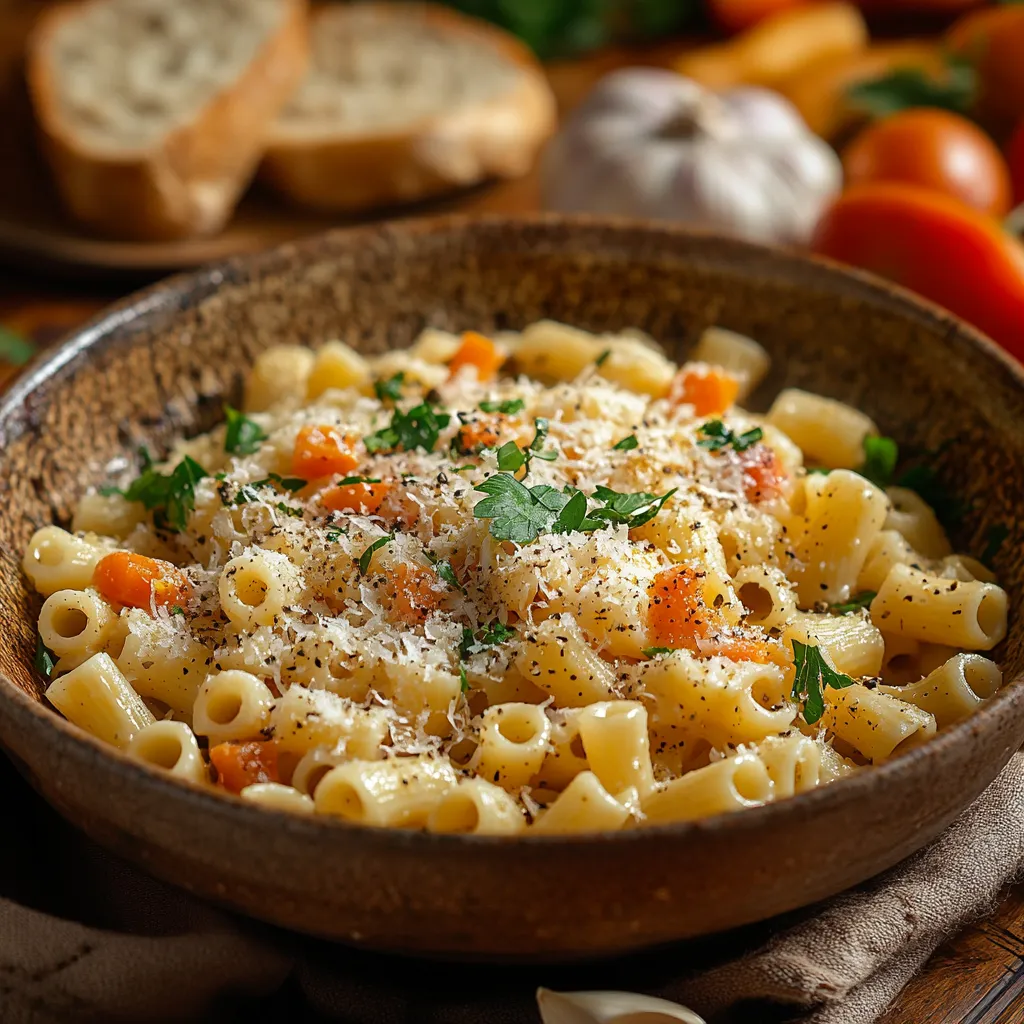Table of Contents
Ditalini pasta might not be as famous as spaghetti or penne, but its small size and big potential make it a pantry essential. This versatile pasta is a key ingredient in hearty soups, refreshing salads, and even baked dishes. Whether you’re a pasta lover looking for new recipes or simply curious about its origins and uses, this guide has you covered. From cooking tips to health benefits and creative ideas, we’ll show you why ditalini pasta deserves the spotlight in your kitchen.
What is Ditalini Pasta?
Origins and History
Ditalini pasta, which means “little thimbles” in Italian, has its roots in Southern Italy. Traditionally, it was used in rustic dishes to stretch ingredients like beans and vegetables, creating hearty meals for large families. Its bite-sized shape makes it a perfect choice for soups, allowing it to blend seamlessly with broths and other ingredients. Over the years, it has become a staple in Italian-American cuisine, appearing in everything from minestrone to pasta salads.
Shape and Texture
The distinctive shape of ditalini pasta—short, tube-like pieces—makes it as functional as it is charming. Its smooth surface and small size help it soak up flavors, making every bite delightful. Unlike larger pasta varieties, ditalini doesn’t overpower dishes but instead complements the texture of beans, vegetables, and meats. Its adaptability makes it a go-to choice for creative cooks.
How to Cook Ditalini Pasta Perfectly
Basic Cooking Instructions
Cooking ditalini pasta might seem straightforward, but a few simple tips can elevate its texture and flavor. Start by bringing a large pot of salted water to a rolling boil—think of the salt as the first layer of seasoning. Add the ditalini and cook it until al dente, usually around 8–10 minutes, but check the package for exact timing. Stir occasionally to prevent sticking.
Once cooked, drain the pasta, but save a cup of the starchy water—it’s a fantastic way to thicken sauces or soups. If you’re not using the pasta immediately, toss it with a splash of olive oil to keep it from clumping.
For more detailed advice on perfecting your pasta dishes, check out this guide to pasta recipes.
Pairing Ditalini with Ingredients
One of the best things about ditalini pasta is its versatility. Its small, tube-like shape makes it ideal for absorbing flavors. Pair it with hearty vegetables like zucchini or spinach for a wholesome meal. In soups, it works wonders with beans and tomatoes, soaking up broth without overpowering other ingredients.
Creamy sauces, such as a light Alfredo, also complement ditalini well. Add protein options like shredded chicken or crumbled sausage for a satisfying dinner. Don’t forget to sprinkle some Parmesan on top to tie it all together!
Delicious Ditalini Pasta Recipes
Soups Featuring Ditalini

Soups are where ditalini pasta truly shines. Classics like Minestrone and Pasta e Fagioli rely on its compact size to create a balanced bite. For a unique twist, try ditalini in a chickpea and rosemary soup. The pasta adds texture without overwhelming the delicate broth.
To enhance your soup’s depth of flavor, sauté onions, garlic, and herbs before adding liquid. This step builds a flavorful base that elevates the dish.
Salads and Side Dishes

Ditalini pasta is also a great base for vibrant salads. Toss it with cherry tomatoes, basil, mozzarella pearls, and a drizzle of balsamic glaze for a refreshing summer dish. Alternatively, mix it with peas, bacon, and a creamy dressing for a crowd-pleasing pasta salad.
For more creative ideas, consider incorporating ingredients like roasted red peppers, olives, and feta cheese. These bold flavors pair wonderfully with the mildness of ditalini.
Main Course Options
Ditalini isn’t just for soups and salads—it also holds its own in main dishes. Try baking it with marinara sauce, mozzarella, and Italian sausage for a comforting casserole. Or, make a one-pot meal by combining cooked ditalini with creamy pesto, shredded chicken, and roasted vegetables.
Want more main course inspiration? Explore hearty chicken casserole ideas that pair well with ditalini pasta.
Tips for Using Ditalini Pasta in Creative Ways
Substitutions and Variations
While ditalini pasta has its unique charm, there are times when you might need a substitute. Macaroni, orzo, and even small shell pasta can step in, depending on the recipe. For a heartier texture, ditaloni (a larger version of ditalini) is a fantastic choice. And for those seeking a healthier option, whole-wheat or gluten-free ditalini are widely available.
Experimenting with flavored pasta, such as spinach or tomato-infused varieties, can add an extra layer of taste and color to your dishes. These variations are especially delightful in simple soups or salads, where the pasta’s flavor can shine.
Unique Serving Ideas
Ditalini pasta isn’t just for traditional recipes—it’s a blank canvas for creativity. Try using it as a filling for stuffed bell peppers, where it mingles with seasoned ground meat and melted cheese. For a quick and easy dinner, toss cooked ditalini with a mix of roasted vegetables, olive oil, and herbs.
Another fun idea is to use ditalini in pasta bakes. Layer it with marinara, ricotta, and mozzarella for a comforting casserole. You can also try it in unexpected ways, like combining it with sautéed shrimp and a lemon butter sauce for a simple yet elegant meal.
For more inspiration, check out this guide on creating flavorful pasta dishes.
Frequently Asked Questions
What kind of pasta is ditalini?
Ditalini pasta is a small, tube-shaped variety with Italian origins. Known as “little thimbles,” it’s often used in soups, pasta salads, and casseroles. Its compact shape allows it to blend seamlessly with other ingredients, making it a versatile choice for many recipes.
What is the closest pasta to ditalini?
If you’re out of ditalini pasta, macaroni, orzo, or small shells can serve as substitutes. Each has a similar size and texture, ensuring your recipe maintains the right balance of flavors.
How do you pronounce ditalini?
The correct pronunciation is dee-tah-LEE-nee, with an emphasis on the “lee.” This Italian word reflects its cultural roots and describes its tiny, thimble-like shape.
How many calories are in ditalini pasta?
A typical serving of ditalini pasta contains around 200 calories per cup (cooked). It’s a good source of carbohydrates and pairs well with nutrient-rich ingredients like vegetables and lean proteins for a balanced meal.
Health Benefits and Nutritional Insights
Nutritional Profile of Ditalini Pasta
Ditalini pasta is a rich source of carbohydrates, which provide energy for your daily activities. A single cup of cooked ditalini contains approximately 200 calories, 7 grams of protein, and a small amount of dietary fiber. Depending on the type you choose—regular, whole-wheat, or gluten-free—the fiber content may vary. Whole-wheat ditalini, in particular, is an excellent option for boosting fiber intake and promoting digestive health.
While pasta is sometimes seen as a calorie-heavy choice, pairing it with nutrient-rich ingredients can create a balanced meal. Adding vegetables, lean proteins, and healthy fats ensures that your dish is both satisfying and nutritious.
Healthier Preparation Methods
Making ditalini pasta dishes healthier doesn’t mean sacrificing flavor. For soups, use a low-sodium broth base to cut back on salt. In salads, swap heavy cream-based dressings for lighter vinaigrettes made with olive oil and lemon juice.
When preparing pasta bakes or casseroles, opt for reduced-fat cheeses or sprinkle smaller amounts for flavor without excess calories. Adding ingredients like spinach, kale, or zucchini to your recipes increases the vitamin content, turning your meal into a nutrient powerhouse.
Where to Buy the Best Ditalini Pasta
Popular Brands and Stores
Ditalini pasta is widely available in supermarkets and online, making it an accessible choice for home cooks. Reputable brands like Barilla, De Cecco, and Delallo offer high-quality options that work perfectly in soups, salads, and main dishes. For specialty varieties, such as whole-wheat or gluten-free ditalini, you might explore health food stores or online retailers.
Choosing Quality Pasta
When selecting ditalini, look for pasta made from durum wheat semolina for a firm texture that holds up during cooking. The pasta should feel smooth but sturdy, indicating its ability to absorb flavors while maintaining its shape.
If you’re interested in trying more pasta ideas, explore gluten-free options and recipes for inspiration.
Conclusion: Why Ditalini Pasta Deserves a Spot in Your Pantry
A Versatile Ingredient for Any Occasion
Whether you’re whipping up a comforting soup, a light pasta salad, or a hearty casserole, ditalini pasta fits the bill. Its small, tube-like shape makes it ideal for absorbing flavors, blending seamlessly with a wide range of ingredients. From traditional Italian recipes to modern culinary experiments, it’s a go-to pasta that adapts to your needs.
Elevate Your Everyday Cooking
What makes ditalini pasta truly special is its ability to transform simple dishes into something extraordinary. With just a few pantry staples and some creativity, you can craft meals that are not only delicious but also satisfying and visually appealing. If you’re looking for more recipe inspiration, check out Food.com for a variety of ideas to incorporate this versatile pasta into your meals.

